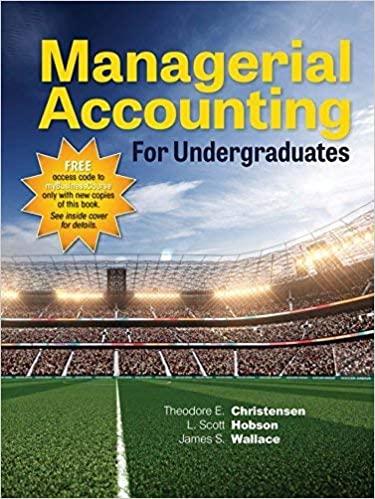Question
Listed below are selected transactions for an Internal Service Fund. Record the journal entries required in the Internal Service Fund. If no entry is required,
Listed below are selected transactions for an Internal Service Fund. Record the journal entries required in the Internal Service Fund. If no entry is required, state "No entry required*
FOR THE FOLLOWING QUESTIONS
1. Purchased supplies on account, $58,000. The fund uses the perpetual inventory method when accounting for supplies.
2. The first semi-annual mortgage payment of $23,500 was made
3. Billed General Fund departments $400,000 for services provided to those departments. Billings to the Enterprise Fund totaled $30,000. 90% of these billings were collected by year end. The remaining 10% is not expected to be collected from the other funds until the second quarter of the next fiscal year.
4. The first semi-annual mortgage payment of $23,500 was made.
5. Billed General Fund departments $400,000 for services provided to those departments. Billings to the Enterprise Fund totaled $30,000. 90% of these billings were collected by year end. The remaining 10% is not expected to be collected from the other funds until the second quarter of the next fiscal year.
6. Purchased supplies on account, $58,000. The fund uses the perpetual inventory method when accounting for supplies.
7. Paid employee salaries, $120,000. Accrued salaries at year end were $13,000. Accrued salaries at the beginning of the year were $9,000.
8. Purchased a building on January 2, 20X2, by paying $100,000 down and borrowing $350,000 on a 6%, 10-year mortgage. Assume semi-annual mortgage payments are due each June 30 and December 31, beginning this year. The building will be depreciated over 20 years with no salvage value using the straight-line method.
Listed below are selected transactions for an Internal Service Fund.
Record the journal entries required in the Internal Service Fund. If no entry is required, state "No entry required*
FOR THE FOLLOWING QUESTIONS
- Purchased supplies on account, $58,000. The fund uses the perpetual inventory method when accounting for supplies.
- The first semi-annual mortgage payment of $23,500 was made
- Billed General Fund departments $400,000 for services provided to those departments. Billings to the Enterprise Fund totaled $30,000.
90% of these billings were collected by year end. The remaining 10% is not expected to be collected from the other funds until the second quarter of the next fiscal year.
- The first semi-annual mortgage payment of $23,500 was made.
- Billed General Fund departments $400,000 for services provided to those departments. Billings to the Enterprise Fund totaled $30,000.
90% of these billings were collected by year end. The remaining 10% is not expected to be collected from the other funds until the second quarter of the next fiscal year.
- Purchased supplies on account, $58,000. The fund uses the perpetual inventory method when accounting for supplies.
- Paid employee salaries, $120,000. Accrued salaries at year end were $13,000. Accrued salaries at the beginning of the year were $9,000.
- Purchased a building on January 2, 20X2, by paying $100,000 down and borrowing $350,000 on a 6%, 10-year mortgage. Assume semiannual mortgage payments are due each June 30 and December 31, beginning this year. The building will be depreciated over 20 years with no salvage value using the straight-line method.
Step by Step Solution
There are 3 Steps involved in it
Step: 1

Get Instant Access to Expert-Tailored Solutions
See step-by-step solutions with expert insights and AI powered tools for academic success
Step: 2

Step: 3

Ace Your Homework with AI
Get the answers you need in no time with our AI-driven, step-by-step assistance
Get Started


